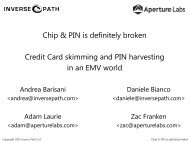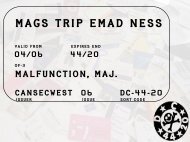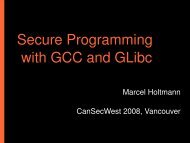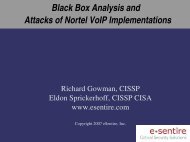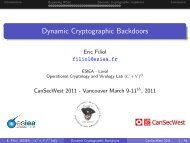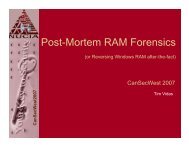Unusual Car Navigation Tricks Injecting RDS-TMC Traffic Information Signals
Unusual Car Navigation Tricks: Injecting RDS-TMC ... - CanSecWest
Unusual Car Navigation Tricks: Injecting RDS-TMC ... - CanSecWest
- No tags were found...
Create successful ePaper yourself
Turn your PDF publications into a flip-book with our unique Google optimized e-Paper software.
Copyright 2007 Inverse Path Ltd.<strong>Injecting</strong> <strong>RDS</strong>-<strong>TMC</strong> <strong>Traffic</strong> <strong>Information</strong> <strong>Signals</strong>West/core07April 18-20, 2007<strong>Unusual</strong> <strong>Car</strong> <strong>Navigation</strong> <strong>Tricks</strong>:<strong>Injecting</strong> <strong>RDS</strong>-<strong>TMC</strong> <strong>Traffic</strong><strong>Information</strong> <strong>Signals</strong>Andrea BarisaniChief Security EngineerDaniele BiancoHardware Hackerhttp://www.inversepath.com
Copyright 2007 Inverse Path Ltd.<strong>Injecting</strong> <strong>RDS</strong>-<strong>TMC</strong> <strong>Traffic</strong> <strong>Information</strong> <strong>Signals</strong>IntroductionDISCLAIMER:All the scripts and/or commands and/or configurations and/orschematics provided in the presentation must be treated as examples,use the presented information at your own risk.Copyright 2007 Inverse Path Ltd.Andrea Barisani Daniele Bianco This work is released under the terms of the Creative CommonsAttribution-NonCommercial-NoDerivs License available athttp://creativecommons.org/licenses/by-nc-nd/3.0.
Copyright 2007 Inverse Path Ltd.<strong>Injecting</strong> <strong>RDS</strong>-<strong>TMC</strong> <strong>Traffic</strong> <strong>Information</strong> <strong>Signals</strong>What's this all about ?●Modern In-<strong>Car</strong> Satellite <strong>Navigation</strong> systems are capable ofreceiving dynamic traffic information●One of the systems being used throughout Europe andNorth America is <strong>RDS</strong>-<strong>TMC</strong> (Radio Data System – <strong>Traffic</strong>Message Channel)●One of the speakers bought a car featuring one of theseSatNavs...he decided to play with it...just a little...●We'll show how <strong>RDS</strong>-<strong>TMC</strong> information can be hijacked andfalsified using homebrew hardware and software
Copyright 2007 Inverse Path Ltd.<strong>Injecting</strong> <strong>RDS</strong>-<strong>TMC</strong> <strong>Traffic</strong> <strong>Information</strong> <strong>Signals</strong>Why bother ?●First of all...hardware hacking is fun and 0wning a car ispriceless ;-P●ok seriously...<strong>Traffic</strong> <strong>Information</strong> displayed on SatNav isimplicitly trusted by drivers, nasty things can be attempted●more important: chicks will melt when you show this...
Copyright 2007 Inverse Path Ltd.<strong>Injecting</strong> <strong>RDS</strong>-<strong>TMC</strong> <strong>Traffic</strong> <strong>Information</strong> <strong>Signals</strong>The Radio Data System●●●<strong>RDS</strong> is used for transmitting data over FM (1187.5 bits/s)Described in European Standard EN50067 (April 1998)Its most prominent function is showing FM Channel Nameon the radio display, also used for Alternate Frequencies,Programme Type, News override, etc.Mono (L+R)19kHz Pilot ToneStereo (L-R)<strong>RDS</strong> Signal15k 19k 23k 38k 53k 57k Freq (Hz)
Copyright 2007 Inverse Path Ltd.<strong>Injecting</strong> <strong>RDS</strong>-<strong>TMC</strong> <strong>Traffic</strong> <strong>Information</strong> <strong>Signals</strong><strong>RDS</strong>-<strong>TMC</strong> Introduction●First introduced around 1997 (Germany), implementedaround Europe in the following years(Italy got it in 2004, Australia will get it in 2007)●●Described in ISO 14819-1<strong>TMC</strong> uses <strong>RDS</strong> for transmission over FM broadcasts
Copyright 2007 Inverse Path Ltd.<strong>RDS</strong>-<strong>TMC</strong>Implementation<strong>Injecting</strong> <strong>RDS</strong>-<strong>TMC</strong> <strong>Traffic</strong> <strong>Information</strong> <strong>Signals</strong>●Despite being a 10 year old protocol, implementation hasbeen slow, SatNav systems have been fully supporting<strong>RDS</strong>-<strong>TMC</strong> only in the last few years●implemented on most in-car SatNav shipped by the originalmanufacturer●External and portable SatNav offer jacks for external FMreceivers which add <strong>RDS</strong>-<strong>TMC</strong> capabilities●●<strong>RDS</strong>-<strong>TMC</strong> is available in both free and commercial services<strong>TMC</strong> can also be transmitted over DAB or satellite radio
Copyright 2007 Inverse Path Ltd.<strong>Injecting</strong> <strong>RDS</strong>-<strong>TMC</strong> <strong>Traffic</strong> <strong>Information</strong> <strong>Signals</strong><strong>RDS</strong>-<strong>TMC</strong> Terminal
Copyright 2007 Inverse Path Ltd.<strong>Injecting</strong> <strong>RDS</strong>-<strong>TMC</strong> <strong>Traffic</strong> <strong>Information</strong> <strong>Signals</strong>The Issue●there's no form of authentication of the data (encryption issupported for commercial services but irrelevant to ourgoals, more on that later)●We tested the feasibility of decoding and injecting arbitrary<strong>TMC</strong> messages against our “victim”●Off-the-shelf components and cheap electronics have beenused●...you'll be the judge of our results...
Copyright 2007 Inverse Path Ltd.<strong>Injecting</strong> <strong>RDS</strong>-<strong>TMC</strong> <strong>Traffic</strong> <strong>Information</strong> <strong>Signals</strong>The Victim
http://rdsd.berlios.de looks like the most promising project)Copyright 2007 Inverse Path Ltd.<strong>Injecting</strong> <strong>RDS</strong>-<strong>TMC</strong> <strong>Traffic</strong> <strong>Information</strong> <strong>Signals</strong>Sniffing <strong>RDS</strong>●We need to get a “raw” FM signal (MPX), there's a numberof tuners that provide an accessible pin for that●We use the FM1216 module from Philips available on manyPCI TV cards (http://pvrhw.goldfish.org)●Once we have the signal we decode the <strong>RDS</strong> sub-carrierusing a TDA7330B <strong>RDS</strong> Demodulator (which samples the1.11875 kHz signal), a PIC for serial conversion anddecoding software (s<strong>RDS</strong>d)●Using custom hardware and software allowed us to fullyunderstand the protocol and decode <strong>TMC</strong> (alternatively
Copyright 2007 Inverse Path Ltd.<strong>Injecting</strong> <strong>RDS</strong>-<strong>TMC</strong> <strong>Traffic</strong> <strong>Information</strong> <strong>Signals</strong>Sniffing <strong>RDS</strong>MPX
Sniffing <strong>RDS</strong>MPXVHF Tuner TDA7330BAnalog SignalPIC16F84Serial InputDigital Signal (Serial)<strong>RDS</strong> Decoder●Main components:1x TDA7330B1x PIC16F841x MAX232Copyright 2007 Inverse Path Ltd.<strong>Injecting</strong> <strong>RDS</strong>-<strong>TMC</strong> <strong>Traffic</strong> <strong>Information</strong> <strong>Signals</strong>
Copyright 2007 Inverse Path Ltd.<strong>Injecting</strong> <strong>RDS</strong>-<strong>TMC</strong> <strong>Traffic</strong> <strong>Information</strong> <strong>Signals</strong>Assembly
Copyright 2007 Inverse Path Ltd.<strong>Injecting</strong> <strong>RDS</strong>-<strong>TMC</strong> <strong>Traffic</strong> <strong>Information</strong> <strong>Signals</strong>Sniffing Circuit
Copyright 2007 Inverse Path Ltd.<strong>Injecting</strong> <strong>RDS</strong>-<strong>TMC</strong> <strong>Traffic</strong> <strong>Information</strong> <strong>Signals</strong>PIC Programming●We program the PIC for converting <strong>RDS</strong> Demodulator dataand send it to the serial port●custom PIC programmer, a variation of the well known JDMone (http://www.semis.demon.co.uk/uJDM/uJDMmain.htm)●output are 0 and 1, bad quality data is shown with * and +(either ignore sequences with bad data or replace them with0 and 1 if you feel lucky)●http://dev.inversepath.com/rds/pic_code.asm
Copyright 2007 Inverse Path Ltd.<strong>Injecting</strong> <strong>RDS</strong>-<strong>TMC</strong> <strong>Traffic</strong> <strong>Information</strong> <strong>Signals</strong>The Output# cat /dev/ttyS0
Copyright 2007 Inverse Path Ltd.<strong>Injecting</strong> <strong>RDS</strong>-<strong>TMC</strong> <strong>Traffic</strong> <strong>Information</strong> <strong>Signals</strong><strong>RDS</strong> ProtocolGroup structure (104 bits):---------------------------------------| Block 1 | Block 2 | Block 3 | Block 4 |--------------------------------------- PI code = 16 bitsBlock structure (26 bits):Group code = 4 bits---------------- ---------------------B0= 1 bit| Data (16 bits) | Checkword (10 bits) |---------------- --------------------- TP= 1 bitBlock 1:PTY = 5 bits---------------------Checkword = 10 bits| PI code | Checkword |---------------------Block 2:---------------------------------------------------| Group code | B0 | TP | PTY | | Checkword |---------------------------------------------------
Copyright 2007 Inverse Path Ltd.<strong>TMC</strong> / Alert-CProtocol<strong>Injecting</strong> <strong>RDS</strong>-<strong>TMC</strong> <strong>Traffic</strong> <strong>Information</strong> <strong>Signals</strong>Block 1:---------------------| PI code | Checkword |---------------------Block 2:-----------------------------------------------------| Group code | B0 | TP | PTY | T | F | DP | Checkword |-----------------------------------------------------Block 3:T= 1 bit-------------------------------------F= 1 bit| D | PN | Extent | Event | Checkword |------------------------------------- DP= 3 bitsBlock 4:D= 1 bit----------------------| Location | Checkword |PN= 1 bit----------------------Extent = 3 bitsEventLocation= 11 bits= 16 bitsCheckword = 10 bits
Copyright 2007 Inverse Path Ltd.<strong>Injecting</strong> <strong>RDS</strong>-<strong>TMC</strong> <strong>Traffic</strong> <strong>Information</strong> <strong>Signals</strong><strong>TMC</strong> / Alert-CPI code => Programme IdentificationGroup code => message type identificationB0 => version codeTP => <strong>Traffic</strong> ProgramPTY => Programme TypeT, F, D => Multi Group messagesDP => Duration and PersistenceD => Diversion AdvicePN => +/- directionExtent => event extensionEvent => event code (see also TMDD – <strong>Traffic</strong> Management Data Dictionary)Location => location code (DAT Location Table - <strong>TMC</strong>F-LT-EF-MFF-v06)
Copyright 2007 Inverse Path Ltd.srdsdSimple <strong>RDS</strong> Decoder<strong>Injecting</strong> <strong>RDS</strong>-<strong>TMC</strong> <strong>Traffic</strong> <strong>Information</strong> <strong>Signals</strong>●Our custom tool for <strong>RDS</strong> decoding:●ISC-style licensed●●●performs nearly full <strong>RDS</strong>-<strong>TMC</strong> (and basic <strong>RDS</strong>) decodingtext and HTML output with Google Map links of GPS datahttp://dev.inversepath.com/rds/srdsdSimple <strong>RDS</strong>-<strong>TMC</strong> Decoder 0.1 || http://dev.inversepath.com/rdsCopyright 2007 Andrea Barisani || Usage: ../srdsd/srdsd [-h|-H|-P|-t] [-d ] [-p] -t display only tmc packets-H HTML output (outputs to /tmp/rds-/rds-*.html)-p PI number-P PI search-d location db path-h this helpNote: -d option expects a DAT Location Table code according to<strong>TMC</strong>F-LT-EF-MFF-v06 standard (2005/05/11)
Copyright 2007 Inverse Path Ltd.<strong>Injecting</strong> <strong>RDS</strong>-<strong>TMC</strong> <strong>Traffic</strong> <strong>Information</strong> <strong>Signals</strong>srdsd – PI Search●●●We must “lock” parsing to the relevant PIEvery FM Channel has its own code (google knows)You can guess the PI code by finding the most recurring16-bit string:# ./srdsd -P rds_dump.raw | tail0010000110000000: 4140 (2180)1000011000000001: 4146 (8601)0001100000000101: 4158 (1805)1001000011000000: 4160 (90c0)0000110000000010: 4163 (0c02)0110000000010100: 4163 (6014)0011000000001010: 4164 (300a)0100100001100000: 4167 (4860)1010010000110000: 4172 (a430)0101001000011000: 4185 (5218)# ./srdsd -p 5218 -d ~/loc_db/ rds_dump.raw
Copyright 2007 Inverse Path Ltd.<strong>Injecting</strong> <strong>RDS</strong>-<strong>TMC</strong> <strong>Traffic</strong> <strong>Information</strong> <strong>Signals</strong>srdsd output – 0A GroupGot <strong>RDS</strong> message (frame 75)Programme Identification: 0101001000011000 (5218)Group type code/version: 0000/0 (0A - Tuning)<strong>Traffic</strong> Program: 1Programme Type: 01001 (9 - Varied Speech)Decoded 0A group:<strong>Traffic</strong> Announcement: 0Music Speech switch: 0Decoder Identification control: 100(Dynamic Switch / PS char 1,2)Alternative Frequencies: 10101010, 10101111(104.5, 105)Programme Service name: 0101001001010100 (RT)Collected PSN: RTL102.5Raw dump | DataCheckword HexBlock 1: | 0101001000011000 0000010100 5218Block 2: | 0000010100101100 0010101101 052cBlock 3: | 1010101010101111 1010100110 aaafBlock 4: | 0101001001010100 0100110101 5254
srdsd output – 8A GroupGot <strong>RDS</strong> message (frame 76)Programme Identification: 0101001000011000 (5218)Group type code/version: 1000/0 (8A - <strong>TMC</strong>)<strong>Traffic</strong> Program: 1Programme Type: 01001 (9 - Varied Speech)Decoded 8A group:Bit X4: 0 (User message)Bit X3: 1 (Single-group message)Duration and Persistence: 000 (no explicit duration given)Diversion advice: 0Direction: 1 (-)Extent: 011 (3)Event: 00001110011 (115 - slow traffic (with average speeds Q))Location: 0000110000001100 (3084)Decoded Location:Location code type: POINTName ID: 11013 (Sv. Grande Raccordo Anulare)Road code: 266 (Roma-Ss16)GPS: 41.98449 N 12.49321 ELink:http://maps.google.com/maps?ll=41.98449,12.49321&spn=0.3,0.3&q=41.98449,12.49321Raw dump | DataCheckword HexBlock 1: | 0101001000011000 0000010100 5218Block 2: | 1000010100101000 1110000111 8528Block 3: | 0101100001110011 0001011001 5873Block 4: | 0000110000001100 0111000011 0c0cCopyright 2007 Inverse Path Ltd.<strong>Injecting</strong> <strong>RDS</strong>-<strong>TMC</strong> <strong>Traffic</strong> <strong>Information</strong> <strong>Signals</strong>
Copyright 2007 Inverse Path Ltd.<strong>Injecting</strong> <strong>RDS</strong>-<strong>TMC</strong> <strong>Traffic</strong> <strong>Information</strong> <strong>Signals</strong>srdsd output – 3A GroupGot <strong>RDS</strong> message (frame 181)Programme Identification: 0101001000011000 (5218)Group type code/version: 0011/0 (3A - ODA ID)<strong>Traffic</strong> Program: 1Programme Type: 01001 (9 - Varied Speech)Decoded <strong>TMC</strong> Sys Info group (3A - AID 52550):Location Table Number: 000001 (1)Alternative Frequency bit: 1Mode of Transmission: 0International Scope: 1National Scope: 0Regional Scope: 0Urban Scope: 0AID: 1100110101000110 (52550)Raw dump | DataCheckword HexBlock 1: | 0101001000011000 0000010100 5218Block 2: | 0011010100110000 1111101000 3530Block 3: | 0000000001101000 0010011011 0068Block 4: | 1100110101000110 1111001001 cd46
Copyright 2007 Inverse Path Ltd.<strong>Injecting</strong> <strong>RDS</strong>-<strong>TMC</strong> <strong>Traffic</strong> <strong>Information</strong> <strong>Signals</strong><strong>Injecting</strong> <strong>RDS</strong>-<strong>TMC</strong>●We use a commercialy available <strong>RDS</strong> encoder (40$ USD),but it's reasonable to build your own (we are working on it)●i2c is being used for communicating with its chipset, we useour custom C application over the supplied client for beingable to send different Group Types●We set all parameters (PI, PTY, etc) + the remaining data(last 3 <strong>RDS</strong> Blocks in Hexadecimal)●●The checkword is automatically computed by the chipsethttp://dev.inversepath.com/rds/i2c_minirds.tar.gz
Copyright 2007 Inverse Path Ltd.<strong>Injecting</strong> <strong>RDS</strong>-<strong>TMC</strong> <strong>Traffic</strong> <strong>Information</strong> <strong>Signals</strong><strong>Injecting</strong> <strong>RDS</strong>-<strong>TMC</strong>unsigned char PI_buf[PI_BUF] = { '\x52', '\x18' }; /* PI */unsigned char PS_buf[PS_BUF] = { 'R', 'A', 'D', 'I', '0', '1', '0', '5' }; /* PS */...unsigned char UDG2_buf[UDG2_BUF] = {'\x35','\x30','\x00','\x66','\xCD','\x46'}; /* 3A */unsigned char UDG1_buf[UDG1_BUF] = {'\x85','\x22','\xC8','\x6C','\x05','\x6F'}; /* 8A */85 22 C8 6C 05 6F10000101 00100010 11001000 01101100 00000101 01101111 Group B0 TP PTY D F DP D PN Extent Event Location8 0 1 9 0 0 2 1 1 1 108 13918A Group Varied Speech Queueing <strong>Traffic</strong>| Check against your country || Location Table |
Copyright 2007 Inverse Path Ltd.<strong>Injecting</strong> <strong>RDS</strong>-<strong>TMC</strong> <strong>Traffic</strong> <strong>Information</strong> <strong>Signals</strong><strong>Injecting</strong> <strong>RDS</strong>-<strong>TMC</strong>Paralleli2c Application <strong>RDS</strong> Encoderi2c ProtocolMPXMain components:FM Transmitter1x Mini<strong>RDS</strong> Encoder(http://www.pira.cz)1x FM transmitterTX Antenna1x PIC16F841x SAA1057 (digital PLL tuning)1x closed dipole antenna
Copyright 2007 Inverse Path Ltd.<strong>Injecting</strong> <strong>RDS</strong>-<strong>TMC</strong> <strong>Traffic</strong> <strong>Information</strong> <strong>Signals</strong>Injection Circuitry
Copyright 2007 Inverse Path Ltd.<strong>Injecting</strong> <strong>RDS</strong>-<strong>TMC</strong> <strong>Traffic</strong> <strong>Information</strong> <strong>Signals</strong>Transmitting FM●●●The FM transmitter can be tuned to arbitrary frequenciesIt's important to have a stable transmitter for data injectionLong distances can be easily covered (but it might bedesirable to keep it short enough to reach only the victim)
Copyright 2007 Inverse Path Ltd.<strong>Injecting</strong> <strong>RDS</strong>-<strong>TMC</strong> <strong>Traffic</strong> <strong>Information</strong> <strong>Signals</strong>Transmitting FMTX “The Sterilizer” Antenna(Resistance is Futile)
Copyright 2007 Inverse Path Ltd.Locking the SatNavTuner<strong>Injecting</strong> <strong>RDS</strong>-<strong>TMC</strong> <strong>Traffic</strong> <strong>Information</strong> <strong>Signals</strong>●<strong>RDS</strong>-<strong>TMC</strong> is detected using 3A Sys Info groupswhich specify the Location Table, the Scope ofthe service and timing settings●Hijack existing channels:1. Find the frequency of a channel that provides <strong>RDS</strong>-<strong>TMC</strong>2. Obscure the channel and send 8A packets (3A notnecessary) when SatNav locks on it (careful timing)●Fake a FM broadcast using 3A groups:1. Find an unused frequency2. Transmit 3A groups continuosly + 8A packets
Copyright 2007 Inverse Path Ltd.<strong>Injecting</strong> <strong>RDS</strong>-<strong>TMC</strong> <strong>Traffic</strong> <strong>Information</strong> <strong>Signals</strong>Being StealthyOption 1: Mix the audio component taken on the AlternateFrequency (AF) for the hijacked channelOption 2: Fake a new channel on an unused frequencyFM Receiver (on AF)RX Antenna<strong>RDS</strong> EncoderAudio componentMPXFM TransmitterTX Antenna
Attack 1:Standard <strong>Traffic</strong> Msgs●We can create:1. Queues2. Bad Weather (Rain, Smog, Fog, Fresh Snow,...)3. Full <strong>Car</strong> Parks4. Overcrowded Service Areas (OMG!)5. Accidents6. Roadworks...and so on...●Not particularly exciting but still nice...it gets betterthough...Copyright 2007 Inverse Path Ltd.<strong>Injecting</strong> <strong>RDS</strong>-<strong>TMC</strong> <strong>Traffic</strong> <strong>Information</strong> <strong>Signals</strong>
Copyright 2007 Inverse Path Ltd.Attack 1:Standard <strong>Traffic</strong> Msgs<strong>Injecting</strong> <strong>RDS</strong>-<strong>TMC</strong> <strong>Traffic</strong> <strong>Information</strong> <strong>Signals</strong>Code 108-Queueing<strong>Traffic</strong>
Copyright 2007 Inverse Path Ltd.Attack 2:Closing Roads<strong>Injecting</strong> <strong>RDS</strong>-<strong>TMC</strong> <strong>Traffic</strong> <strong>Information</strong> <strong>Signals</strong>●We can close arbitrary roads, bridges and tunnels with anumber of Events: Closed, No through traffic, Accidents●The SatNav will pop-up the event (even if no diversion isspecified on our model) and ask the user for a detour●If the closed road is encountered during re-calculation of theroute (which is a very common thing) it will be silentlyavoided●this attack is also known as “keep your parents fromreaching home”...
Copyright 2007 Inverse Path Ltd.Attack 2:Closing Roads<strong>Injecting</strong> <strong>RDS</strong>-<strong>TMC</strong> <strong>Traffic</strong> <strong>Information</strong> <strong>Signals</strong>Code 401 - Closed
Copyright 2007 Inverse Path Ltd.Attack 2:Closing Roads<strong>Injecting</strong> <strong>RDS</strong>-<strong>TMC</strong> <strong>Traffic</strong> <strong>Information</strong> <strong>Signals</strong>Normal route to homeRoute avoiding the“Closed” Event
Copyright 2007 Inverse Path Ltd.Attack 3:Security Messages<strong>Injecting</strong> <strong>RDS</strong>-<strong>TMC</strong> <strong>Traffic</strong> <strong>Information</strong> <strong>Signals</strong>●The Event table supports a number of security relatedmessages●●We doubt anyone ever used them so farThey pose a very interesting target for social engineeringpurposes (Homeland Security would freak out)
Copyright 2007 Inverse Path Ltd.Attack 3:Security Messages<strong>Injecting</strong> <strong>RDS</strong>-<strong>TMC</strong> <strong>Traffic</strong> <strong>Information</strong> <strong>Signals</strong>Code 1518 – Terrorist Incident
Copyright 2007 Inverse Path Ltd.Attack 3:Security Messages<strong>Injecting</strong> <strong>RDS</strong>-<strong>TMC</strong> <strong>Traffic</strong> <strong>Information</strong> <strong>Signals</strong>Code 1481 – Air raid, danger
Copyright 2007 Inverse Path Ltd.Attack 3:Security Messages<strong>Injecting</strong> <strong>RDS</strong>-<strong>TMC</strong> <strong>Traffic</strong> <strong>Information</strong> <strong>Signals</strong>AirportEventCode 978 – Air crash
Copyright 2007 Inverse Path Ltd.Attack 3:Security Messages<strong>Injecting</strong> <strong>RDS</strong>-<strong>TMC</strong> <strong>Traffic</strong> <strong>Information</strong> <strong>Signals</strong>Code 1516 – Bomb alert
Copyright 2007 Inverse Path Ltd.Attack 3:Security Messages<strong>Injecting</strong> <strong>RDS</strong>-<strong>TMC</strong> <strong>Traffic</strong> <strong>Information</strong> <strong>Signals</strong>●Security messages can be pop-up, if they affect currentroute●Video Clip time!Code 1571Security alert. Stationary traffic
Copyright 2007 Inverse Path Ltd.<strong>Injecting</strong> <strong>RDS</strong>-<strong>TMC</strong> <strong>Traffic</strong> <strong>Information</strong> <strong>Signals</strong>Other funny messagesCode 1456 – Bull Fight (you never know...)Code 1560 – Delays due to parade...and many more...(no you can't have a pony)
Copyright 2007 Inverse Path Ltd.<strong>Injecting</strong> <strong>RDS</strong>-<strong>TMC</strong> <strong>Traffic</strong> <strong>Information</strong> <strong>Signals</strong>Implementation Issues●On our Honda integrated SatNav we've seen that:➔The PI is not associated to the frequency, any PI can beused on any frequency for hijacking➔Total cancellation (Event: 2047, Location: 65535) is nothonoured➔➔Broadcast message (Location: 65535) is not honouredDiversion bit is ignored for some categories and alwaysassumed = 1●We expect other SatNav systems to have similar or evenmore interesting issues
Copyright 2007 Inverse Path Ltd.<strong>Injecting</strong> <strong>RDS</strong>-<strong>TMC</strong> <strong>Traffic</strong> <strong>Information</strong> <strong>Signals</strong><strong>RDS</strong>-<strong>TMC</strong> Encryption●<strong>TMC</strong> supports a very lightweight encryption for commercialservices●●●●●●Described in ISO 14819-6It's used for signal discrimination rather than authenticationOnly the Location Code is encryptedIt involves bitwise operations against a keyThe key can be trivially broken by sampling some dataTerminals that support encryption are also expected toaccept un-encrypted data, so injection is still possible
Copyright 2007 Inverse Path Ltd.<strong>Injecting</strong> <strong>RDS</strong>-<strong>TMC</strong> <strong>Traffic</strong> <strong>Information</strong> <strong>Signals</strong>Security Considerations●<strong>RDS</strong>-<strong>TMC</strong> can be trivially injected●Drivers don't tend to have any security awareness towardstheir SatNav, social engineering, forced detours and panicattacks are possible●We don't think it's “The End Of The World As We Know It”but these systems should be authenticated considering theirincreased usage and expansion●These technologies have a very long life span and “patching”is not easy●We hope to increase awareness about these kind of problems
Copyright 2007 Inverse Path Ltd.<strong>Injecting</strong> <strong>RDS</strong>-<strong>TMC</strong> <strong>Traffic</strong> <strong>Information</strong> <strong>Signals</strong>The Future●<strong>TMC</strong> is also supported over DAB and satellite radio, it'sharder to inject compared to FM but still possible●TPEG (Transport Protocol Experts Group) is the newstandard designed for replacing <strong>TMC</strong>. It supports encryptionbut it's still optional. (http://tpeg.org)●GST (Global System for Telematics) is an impressive newarchitecture for delivering a number of services. It's backedup by many manufacturers and it will support PKI for billingand transport purposes. Adoption is many years away fromnow. (http://gstforum.org)
Copyright 2007 Inverse Path Ltd.<strong>Injecting</strong> <strong>RDS</strong>-<strong>TMC</strong> <strong>Traffic</strong> <strong>Information</strong> <strong>Signals</strong>Similar Systems●Microsoft DirectBand (http://www.directband.com), used forMSN Direct, is another FM subcarrier channel for datatransmission●It has a larger bandwidth (15 times that of <strong>RDS</strong>) and fullencryption●Other than special wristwatches it's also been used onSatNav systems for traffic information(http://garmin.msndirect.com)●Closed standard, not available in Europe, looks verypromising...we'd love to play with that too ;)
Copyright 2007 Inverse Path Ltd.<strong>Injecting</strong> <strong>RDS</strong>-<strong>TMC</strong> <strong>Traffic</strong> <strong>Information</strong> <strong>Signals</strong>The EndThanks for listening!Questions?(shameless plug)http://www.inversepath.com<strong>Traffic</strong> Sign Images used with permission fromhttp://gettingaroundgermany.home.att.netThanks to Brian Purcell



